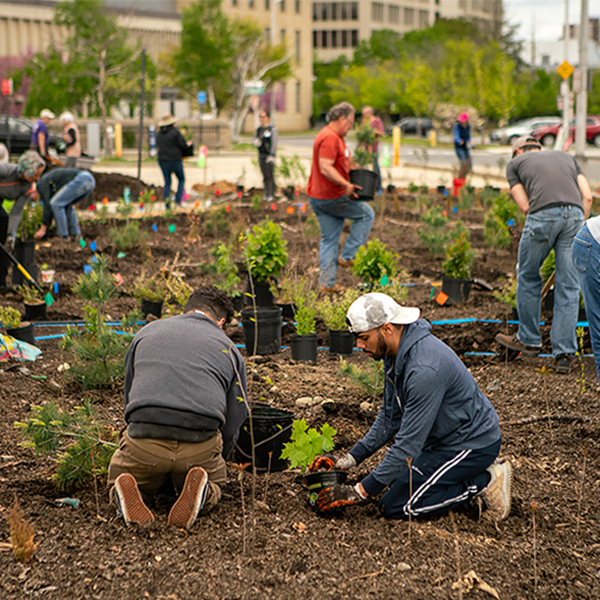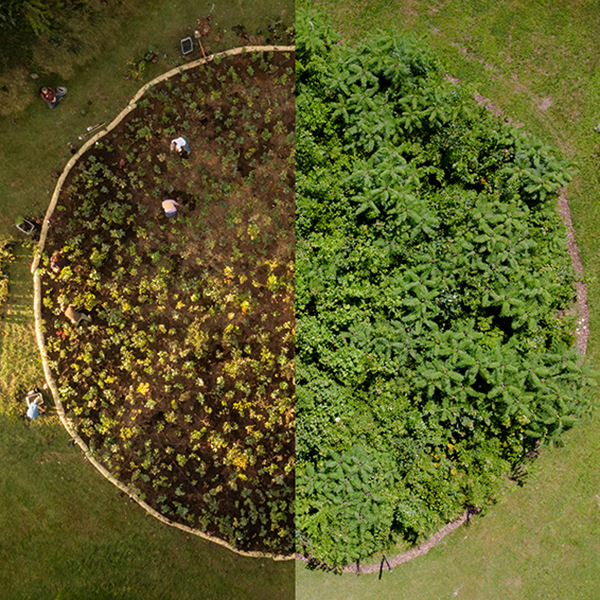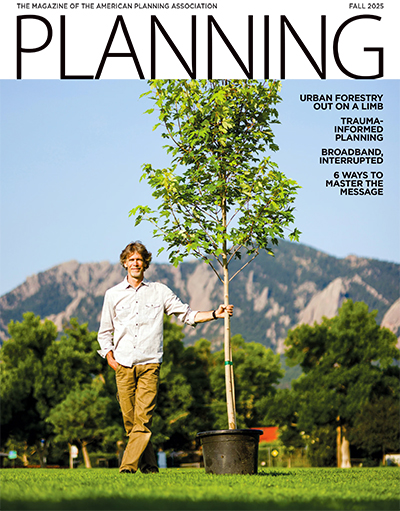Oct. 9, 2025
Geoffrey Pressac was impressed. Although it had been just three years since he and other volunteers planted a Miyawaki mini forest in Lyon, France, it had already grown to well over 10 feet tall. The result was an oasis of green in a sea of dried grass and dirt as France endured another blistering summer heat wave.
The dense mini forest was the work of l'Association Boomforest, planted with the goal of beautifying the neighborhood, increasing biodiversity, and helping fight rising urban heat. Pressac, who is an active volunteer with and treasurer of Boomforest, took my wife and me on a tour to see three of the organization's nine mini forests in the Lyon area.
Mini forests sprout up across France
Guillaume Dozier, a Boomforest project leader, says the organization was born out of an exercise in participatory budgeting conducted in Paris. Enrico Fusto, Boomforest's founder, had proposed planting a Miyawaki mini forest on a barren slope along a major city road. The public voted to fund it, and now, eight years later, there are more than 20 such forests throughout France.
Other organizations are leading similar efforts in Belgium, the Netherlands, Germany, Great Britain, and, more recently, the U.S. But each group draws its inspiration from the work of Akira Miyawaki, a Japanese botanist who developed a special technique for planting dense and highly diverse forests of native trees through years of experimentation.
The goal is to engage residents in re-establishing patches of the "native climax forest." Every forest goes through stages of growth or "succession," with different tree species thriving in varying amounts of light and shade. As trees grow larger, they shade out species from earlier stages, culminating in the climax forest that remains stable until patches are opened by windstorms, flooding, and forest fires, causing the process to repeat itself.
The approach also helps fight the effects of habitat loss and a changing climate. Every project depends on recruiting volunteers to prepare the soil and plant the mini forest. The group removes weeds and sometimes waters the forest for the first three years, after which it becomes self-sustaining.
Hannah Lewis, author of Mini-Forest Revolution: Using the Miyawaki Method to Rapidly Rewild the World and narrator of the new film, Making a Mini-Forest, described the Miyawaki technique in detail in those resources. Lewis, an agricultural economist, likes the method because of how it connects people with nature and provides civic benefits. For example, while working with Minnesota-based nonprofit Renewing the Countryside, she helped organize a partnership in St. Paul with the historic Pilgrim Baptist Church and Maxfield Elementary School to plant a mini forest in the Rondo neighborhood — an area affected by an urban highway.
Lewis sees great potential in planting mini forests in schoolyards, universities, and corporate campuses. Local governments also can make great partners, particularly if they have climate action or tree canopy plans. They can help identify suitable sites and provide funding for saplings and planting equipment, while organizations like Renewing the Countryside and Boomforest provide expertise and volunteer labor.
A growing movement
Miyawaki mini forests are catching on in the U.S. in more places than just St. Paul.
Alexandra Ionescu, associate director of regenerative projects at Biodiversity for a Livable Climate in Cambridge, Massachusetts, helped organize the first Northeast Miniforest Summit this past summer. With more than 500 registrants, the two-day symposium brought together educators, scientists, local government officials, volunteers, and others with an interest in mini forests to share insights about how to increase the use of the Miyawaki method.

Worcester Public Library's former underused parking lot was a living classroom for community volunteers on the day of the forest planting. Photo courtesy of Alexandra Ionescu/Biodiversity for a Livable Climate.

Danehy Park Forest in Cambridge, Massachusetts, the first Miyawaki forest in the northeastern U.S., shows years of complex growth and biodiversity. Photo courtesy of Danehy Park Forest/SUGi.
"It is wonderful to see people coming to the planting day with so much excitement," Ionescu says. "They come back to see the progress of the trees they helped plant and form this connection with place."
Ionescu sees a potential role for planners to identify suitable mini forest sites, one of the largest challenges. Other mini forest programs have been launched by the Natural Urban Forests in Seattle, Washington; Urban Pocket Forest, Berkeley, California; and LA Microforests, Los Angeles.
Meanwhile, researchers like Nicholas Geron, assistant professor of geography and sustainability at Salem State University in Massachusetts, are actively evaluating the impact of mini forests using thermal drones. As part of a study in Cambridge, Massachusetts, Geron found that mini forests are cooler by 20 degrees Celsius (36 degrees Fahrenheit) than surrounding grass at the hottest time of the day. Additionally, a three-year-old mini forest was found to be similar in average temperature to mature park trees and street trees planted more than 20 years ago but has a lower maximum temperature and less variation within the forest.
So, if you start seeing explosions of green vegetation on once-barren sites, they might just be Miyawaki mini forests — another tool to help communities in the fight against habitat loss and rising urban heat.




